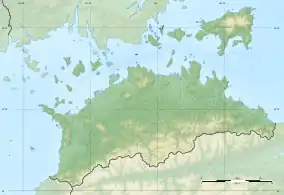Sanuki Kokubunni-ji
The Sanuki Kokubun-niji ruins (讃岐国分尼寺跡) is an archaeological site with the ruins of a Nara period Buddhist nunnery in the Kokubunji neighborhood of the city of Takamatsu, Kagawa Prefecture Japan. Its ruins were designated as a National Historic Site in 1928.[1]
| Sanuki Kokubun-niji ruins | |
|---|---|
| Native name 讃岐国分尼寺跡 | |
_soseki.JPG.webp) Foundation stone from the Sanuki Kokubun-niji ruins | |
| Type | Buddhist temple ruins |
| Location | Takamatsu, Kagawa, Japan |
| Coordinates | 34°18′35.31″N 133°57′44.88″E |
| Founder | c.Emperor Shōmu |
| Built | Nara period |
 Location of Sanuki Kokubun-niji ruins in Kagawa Prefecture  Sanuki Kokubunni-ji (Japan) | |
History
The Shoku Nihongi records that in 741, as the country recovered from a major smallpox epidemic, Emperor Shōmu ordered that a monastery and nunnery be established in every province, the kokubunji (国分寺).[2][3] These temples were built to a semi-standardized template, and served both to spread Buddhist orthodoxy to the provinces, and to emphasize the power of the Nara period centralized government under the Ritsuryō system.[4] While the sites of most of the kokubun-ji monasteries are either known or have been discovered, very few sites of the kokubun-niji nunneries are known.
The Sanuki Kokubun-niji site is located approximately two kilometers northeast of the Sanuki Kokubun-ji. The site occupies a trapezoidal compound 180-210 meters east-to-west by 180 meters north-to-south and per archaeological excavations conducted in 1982 was found to contain 19 foundation stones from what is presumed to have been the Main Hall of the nunnery, as well a roof tiles and bricks. The spacing and orientation of the foundations indicates a seven by four bay building. It is believed that the Lecture Hall and residence was lined up from south to north, as a further excavation has found more large foundation stones scatters on the north side of the precinct, with a rain drainage ditch in parallel. However, excavations are hampered by the presence of a later Buddhist temple, Hokke-ji, which now occupies the approximate center of the site, and many details of the original Nara-period temple remain uncertain.[5]
The site is about a 20-minute walk from Hashioka Station on the JR Shikoku Yosan Line.[5]
References
- "讃岐国分尼寺跡" (in Japanese). Agency for Cultural Affairs. Retrieved August 20, 2020.
- Brown, Delmer M. (1993). Cambridge History of Japan vol. I. Cambridge University Press. p. 255.
- Yiengpruksawan, Mimi Hall (1998). Hiraizumi: Buddhist Art and Regional Politics in Twelfth-Century Japan. Harvard University Press. pp. 22f.
- Shively, Donald H.; McCullough, William H. (1999). Cambridge History of Japan vol. II (p.31f.). Cambridge University Press.
- Isomura, Yukio; Sakai, Hideya (2012). (国指定史跡事典) National Historic Site Encyclopedia. 学生社. ISBN 4311750404.(in Japanese)
External links
- Takamatsu City home page(in Japanese)